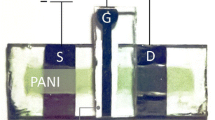Abstract
Memristors and memristive devices represent a splendid area of research due to the unique possibilities for the realization of new types of computer hardware elements and mimicking several essential properties of the nervous system of living beings. The organic memristive device was developed as an electronic single-device analogue of the synapse, suitable for the realization of circuits allowing Hebbian type of learning. This work is dedicated to the realization of the active channel of organic memristive devices by polyelectrolyte self-assembling (layer-by-layer technique). Stable and reproducible electrical characteristics of the device were obtained when the thickness of the active channel was more than seven bilayers. The device revealed rectifying behaviour and the presence of hysteresis—important properties for the realization of neuromorphic systems with synapse-like properties of the individual elements. Compared to previously reported results on organic memristive devices fabricated using other methods, the present device does not require any additional doping that is usually performed through acid treatment. Such a behaviour is extremely important for the cases in which biological systems (nervous cells, slime mould, etc.) must be interfaced with the system of organic memristive devices, since acid treatment can kill living beings.

Similar content being viewed by others
References
D. B. Strukov, G. S. Snider, D. R. Stewart, and R. S. Williams, Nature 453, 80 (2008).
L. Chua, IEEE Trans. Circuit Theory 18, 507 (1971).
J. Borghetti, Z. Li, J. Straznicky, X. Li, D. A. A. Ohlberg, W. Wu, D. R. Stewart, and R. S. Williams, Proc. Natl. Acad. Sci. USA 106, 1699 (2009).
S. H. Jo, K.-H. Kim, and W. Lu, Nano Lett. 9, 496 (2009).
Z. M. Liao, C. Hou, Q. Zhao, D.-S. Wang, Y.-D. Li, and D.-P. Yu, Small 21, 2377 (2009).
A. Shkabko, M. H. Aguirre, I. Marozau, T. Lippert, and A. Weidenkaff, Appl. Phys. Lett. 95, 152109 (2009).
L. A. Agapito, S. Alkis, J. L. Krause, and H.-P. Chen, J. Phys. Chem. C 113, 20713 (2009).
Y. V. Pershin and M. Di Ventra, Adv. Phys. 60, 145 (2011).
V. Erokhin and M. P. Fontana, J. Computational Theor. Nanosci. 8, 313 (2011).
V. Erokhin, T. Berzina, and M. P. Fontana, J. Appl. Phys. 97, 064501 (2005).
D. O. Hebb, The Organization of Behavior. A Neurophysiological Theory. Second Edition, Wiley and Sons, New York (1961).
D. B. Strukov, J. L. Borghetti, and R. S. Williams, Small 9, 1058 (2009).
I. Valov, E. Linn, S. Tapperzhofen, S. Schmelzer, J. van den Hurk, F. Lentz, and R. Waser, Nature Communications 4, 1771 (2013).
E. T. Kang, K. G. Neoh, and K. L. Tan, Progr. Polymer Sci. 23, 277 (1998).
T. Berzina, V. Erokhin, and M. P. Fontana, J. Appl. Phys. 101, 024501 (2007).
T. Berzina, S. Erokhina, P. Camorani, O. Konovalov, V. Erokhin, and M. P. Fontana, ACS Appl. Mater. Interfaces 1, 2115 (2009).
V. Erokhin, T. Berzina, K. Gorshkov, P. Camorani, A. Pucci, L. Ricci, G. Ruggeri, R. Sigala, and A. Schuz, J. Mater. Chem. 22, 22881 (2012).
V. I. Troitsky, T. S. Berzina, and M. P. Fontana, Mater. Sci. Engineer. C 22, 239 (2002).
G. Decher, Science 277, 1232 (1997).
J. S. Lee, J. Cho, C. Lee, I. Kim, J. Park, Y.-M. Kim, H. Shin, J. Lee, and F. Caruso, Nature Nanotechnology 2, 790 (2007).
C. Lee, I. Kim, H. Shin, S. Kim, and J. Cho, Langmuir 25, 11276 (2009).
J. H. Cheung, W. B. Stokton, and M. F. Rubner, Macromolecules 30, 2712 (1997).
S. Erokhina, V. Erokhin, C. Nicolini, F. Sbrana, D. Ricci, and E. Di Zitti, Langmuir 19, 766 (2003).
T. Berzina, A. Smerieri, G. Ruggeri, M. Bernabo, V. Erokhin, and M. P. Fontana, Mater. Sci. Engineer. C 30, 407 (2010).
V. Erokhin, Int. J. Unconventional Computing 23, 1350112 (2013).
Author information
Authors and Affiliations
Corresponding author
Rights and permissions
About this article
Cite this article
Erokhina, S., Sorokin, V. & Erokhin, V. Polyaniline-based organic memristive device fabricated by layer-by-layer deposition technique. Electron. Mater. Lett. 11, 801–805 (2015). https://doi.org/10.1007/s13391-015-4329-1
Received:
Accepted:
Published:
Issue Date:
DOI: https://doi.org/10.1007/s13391-015-4329-1




